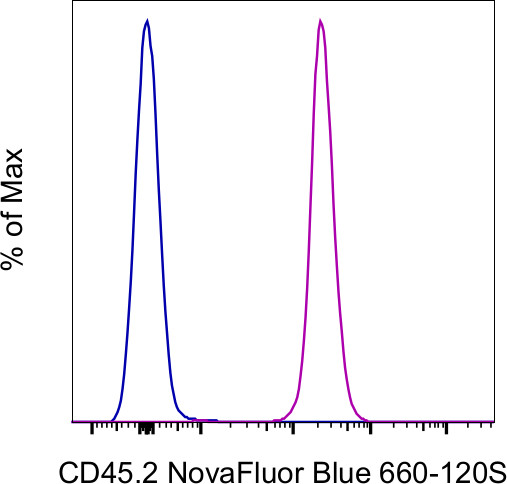Search Thermo Fisher Scientific
Invitrogen
CD45.2 Monoclonal Antibody (104), NovaFluor™ Blue 660-120S, eBioscience™
FIGURE: 1 / 2
CD45.2 Antibody (M027T02B08-A) in Flow


Product Details
M027T02B08-A
Species Reactivity
Host/Isotype
Class
Type
Clone
Conjugate
Excitation/Emission Max
Form
Concentration
Purification
Storage buffer
Contains
Storage conditions
RRID
Product Specific Information
Description: The 104 monoclonal antibody reacts with the mouse CD45 molecule, the leukocyte common antigen (LCA) in CD45.2-expressing mouse strains. The strains that express CD45.2 include the most commonly used mouse strains C57BL/6, BALB/c, C58, DBA/1, DBA/2, C3H/He, CBA, 129, A and AKR. CD45.2 is expressed by all leukocytes in these strains.
Each product contains 1 vial of NovaFluor conjugate and 1 vial of CellBlox Plus Blocking Buffer .
Applications Reported: The 104 antibody has been reported for use in flow cytometric analysis.
Applications Tested: The 104 antibody has been tested by flow cytometric analysis of mouse splenocytes. This can be used at less than or equal to 0.5 µg per test. A test is defined as the amount (µg) of antibody that will stain a cell sample in a final volume of 100 µL. Cell number should be determined empirically but can range from 10^5 to 10^8 cells/test. It is recommended that the antibody be carefully titrated for optimal performance in the assay of interest.
NovaFluor dyes are not compatible with DNA intercalating viability dyes. Do not use viability dyes such as propidium iodide, 7-actinomycin D (7-AAD) and DAPI. Invitrogen LIVE/DEAD Fixable Dead Cell stains are recommended for use with NovaFluor dyes.
This NovaFluor conjugate has been updated to ship with CellBlox Plus Blocking Buffer (Cat. No. (C001T06F01)). This buffer contains formulation improvements over CellBlox. CellBlox Plus Blocking Buffer is required for optimal staining with NovaFluor conjugates and should be used in all experiments where NovaFluor conjugates are used. Whenever possible, we recommend adding CellBlox Plus Blocking Buffer to antibody cocktails/master mixes prior to combining with cells. Add 5 µL per sample (regardless of the number of NovaFluors in your panel) to use the antibody cocktail as intended. For single-color controls, use 5 µL of CellBlox Blocking Buffer per 100 µL of cell sample containing 10^3 to 10^8 cells.
NovaFluor conjugates are based on Phiton™ technology utilizing novel nucleic acid dye structures that allow for engineered fluorescent signatures with consideration for spillover and spread impacts. Learn more
Excitation: 509 nm; Emission: 665 nm; Laser: 488 nm (Blue) Laser
Target Information
CD45.2 (LCA, leukocyte common antigen) is a receptor-type protein tyrosine phosphatase ubiquitously expressed in all nucleated hematopoietic cells, comprising approximately 10% of all surface proteins in lymphocytes. CD45.2 glycoprotein is crucial in lymphocyte development and antigen signaling, serving as an important regulator of Src-family kinases. CD45.2 protein exists as multiple isoforms as a result of alternative splicing; these isoforms differ in their extracellular domains, whereas they share identical transmembrane and cytoplasmic domains. These isoforms differ in their ability to translocate into the glycosphingolipid-enriched membrane domains and their expression depends on cell type and physiological state of the cell. Besides the role in immunoreceptor signaling, CD45.2 is important in promoting cell survival by modulating integrin-mediated signal transduction pathway and is also involved in DNA fragmentation during apoptosis. CD45RA is an isoform of the CD45 complex and has restricted expression between different subtypes of lymphoid cells.
For Research Use Only. Not for use in diagnostic procedures. Not for resale without express authorization.
How to use the Panel Builder
Watch the video to learn how to use the Invitrogen Flow Cytometry Panel Builder to build your next flow cytometry panel in 5 easy steps.
References (0)
Bioinformatics
Protein Aliases: CD45; CD45 antigen; GP180; L-CA; LCA; Leukocyte common antigen; Ly-5; LY5; Lymphocyte antigen 5; lymphocyte common antigen; Receptor-type tyrosine-protein phosphatase C; T200; T200 glycoprotein
Gene Aliases: B220; Cd45; CD45R; L-CA; loc; Ly-5; Lyt-4; Ptprc; T200
UniProt ID: (Mouse) P06800
Entrez Gene ID: (Mouse) 19264

Performance Guarantee
If an Invitrogen™ antibody doesn't perform as described on our website or datasheet,we'll replace the product at no cost to you, or provide you with a credit for a future purchase.*
Learn more
We're here to help
Get expert recommendations for common problems or connect directly with an on staff expert for technical assistance related to applications, equipment and general product use.
Contact tech support

